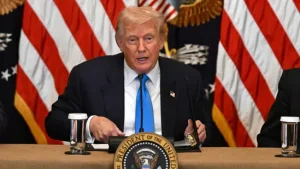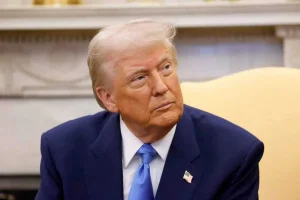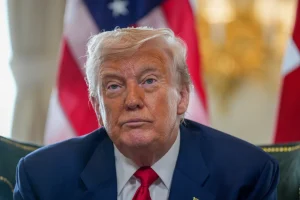Washington D.C. – US President Donald Trump has hit back strongly after an appeals court declared most of his tariffs illegal. In his fiery response, Trump rejected the decision, branding the court as “highly partisan” and vowing to take the fight to the Supreme Court. Trump On US Court Tariff Ruling has since emerged as a defining flashpoint in the debate over presidential authority and trade policy.
Trump Calls Ruling a “Total Disaster”

The US Court of Appeals for the Federal Circuit in Washington DC ruled that Trump exceeded his powers by imposing tariffs under emergency authority laws. Despite the ruling, the tariffs will remain in effect until October 14, giving the administration time to appeal.
Reacting swiftly, Trump On US Court Tariff Ruling described the decision as a “total disaster” for the United States if it were allowed to stand. He insisted that all tariffs remain in place and declared: “Today a highly partisan appeals court incorrectly said that our tariffs should be removed, but they know the United States of America will win in the end.”
The forceful remarks underline the political and legal significance of Trump On US Court Tariff Ruling, framing tariffs as essential for national strength.
Trump’s Defense of Tariffs


Trump emphasized that eliminating tariffs would weaken the country financially. He said the United States would not tolerate “enormous trade deficits and unfair barriers imposed by other countries, friend or foe.” According to him, the decision would harm manufacturers, farmers, and American workers if it were upheld.
At the start of the Labor Day weekend, Trump urged Americans to remember that tariffs are the “best tool” to help workers and strengthen industries. “With the help of the Supreme Court, we will use them to make America rich, strong, and powerful again,” he declared. These statements reinforce the centrality of Trump On US Court Tariff Ruling to his broader political message of economic nationalism.
What the Court Said?
The appeals court ruled that Trump had no explicit authority under the International Emergency Economic Powers Act (IEEPA) to impose tariffs. While the statute grants the president broad emergency powers, it does not mention tariffs, duties, or taxes.
“The statute bestows significant authority on the President to undertake a number of actions in response to a declared national emergency, but none of these explicitly include the power to impose tariffs,” the court explained.
The decision invalidates Trump’s so-called “reciprocal” tariffs introduced in April during his trade war, as well as another set of tariffs from February targeting China, Canada, and Mexico. However, tariffs on steel and aluminum, imposed under different statutes, remain unaffected. The distinction has made Trump On US Court Tariff Ruling particularly significant, as it highlights limits on emergency powers.
Trump’s Legal Argument Under IEEPA
Trump had justified his actions under IEEPA, a law enacted in 1977 to deal with national emergencies through sanctions or freezing assets. He became the first US president to invoke IEEPA to impose tariffs.
However, the court noted that Congress did not intend for IEEPA to grant unlimited tariff powers. “It seems unlikely that Congress intended, in enacting IEEPA, to depart from its past practice and grant the President unlimited authority to impose tariffs,” the ruling stated.
The rejection of this interpretation has made Trump On US Court Tariff Ruling a central issue in defining executive powers.
Lawsuits Behind the Case
The court’s ruling stemmed from lawsuits filed by five small US businesses and a coalition of 12 Democratic-led states. Both argued that the Constitution grants Congress, not the president, authority over tariffs and taxation.
The lawsuits stressed that any delegation of this power must be explicit and limited. Trump’s use of IEEPA for tariffs, they argued, violated this constitutional principle. The emergence of Trump On US Court Tariff Ruling from these cases demonstrates the wider legal consensus against Trump’s interpretation of presidential authority.
Broader Political Implications


The decision marks a serious challenge to Trump’s economic legacy. Tariffs were a cornerstone of his “America First” agenda, aimed at reducing trade deficits and supporting domestic industries. The setback forces a re-examination of how far a president can unilaterally reshape trade policy.
Trump’s vocal defense shows that he intends to make Trump On US Court Tariff Ruling part of his political narrative, portraying himself as a defender of American workers against hostile foreign trade practices and “partisan” courts.
Awaiting the Supreme Court
For now, tariffs remain in effect until October 14. The Trump administration plans to appeal the decision to the Supreme Court, where the outcome will likely determine the fate of his trade policies.
Businesses, states, and policymakers are closely watching the next steps. A Supreme Court ruling affirming the appeals court would curtail presidential use of emergency powers for tariffs. Conversely, a reversal could embolden future presidents to act more aggressively in trade policy.
The pending appeal ensures that Trump On US Court Tariff Ruling will dominate both legal and political debates in the months ahead.
Final Remarks
The battle over tariffs has escalated into a defining constitutional and political clash. By rejecting the appeals court decision and pledging to fight at the Supreme Court, Trump has made Trump On US Court Tariff Ruling a rallying point for his supporters.
The controversy underscores not only the stakes of Trump’s trade agenda but also broader questions about the limits of executive authority in the United States. As the case advances, the future of presidential powers over trade—and the balance between Congress and the White House—hangs in the balance.

